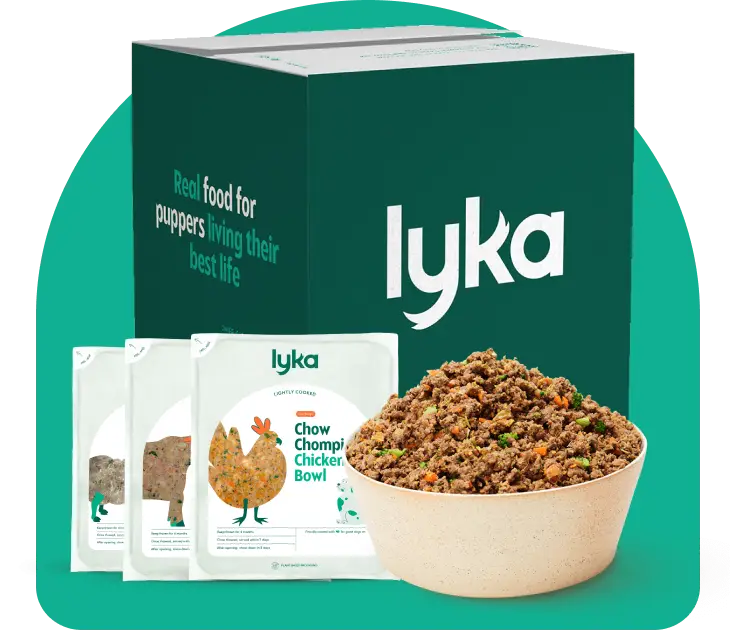Seeing your dog in discomfort is tough, especially when you can’t pinpoint the exact cause. Even if you suspect it’s their food, it can be tricky to know which ingredient is the problem.
Food sensitivities are on the rise in dogs and are one of the most common issues seen by vets, making it a costly problem for dog parents. The good news is that food sensitivities can be managed with a few adjustments to their diet.
What’s the difference between a food allergy and a food intolerance?
If your dog has chronically itchy skin, vomiting, or diarrhoea, it could be a food allergy, intolerance, or sensitivity.
A food allergy is a reaction to a particular ingredient or additive. The body mistakenly believes it’s a threat, like a pathogen, and triggers an immune response.
When your dog ingests a food allergen, antibodies alert the immune system and connect to mast cells. Mast cells contain histamines that fight allergens, but they also cause redness, inflammation, itching or sneezing — the common symptoms you may notice in your dog.
Food allergies are rare and thought to affect less than 1% of the canine population.
A food intolerance or sensitivity is a dog’s inability to digest a particular ingredient or additive but doesn’t trigger an immune response.
Symptoms of a food allergy in dogs
An allergic reaction often happens quickly as your dog’s immune system goes into immediate action to defend their body against the trigger.
The most common signs of a food allergy include:
Acute or chronic itching
Biting or gnawing the skin
Incessant licking or rubbing, hair-loss, fur staining around your dog’s muzzle, paws and base of tail
Inflammation (redness and swelling)
Hives (urticaria) or raised bumps on the skin
Increased eye discharge, red or watery eyes
Skin lesions or pustules
Skin or ear infections
Canine Atopic Dermatitis
If your dog has experienced a negative response to food and has developed a skin issue (cutaneous adverse food reaction), speak to your vet, as chronic itching can lead to secondary skin infections.
Anaphylaxis is a rare allergic reaction. If you notice your dog experience swelling or breathing difficulties, or if they’ve collapsed, get urgent veterinary attention.
Symptoms of a food intolerance or sensitivity in dogs
Gastrointestinal issues — including vomiting, diarrhoea and flatulence — are often caused by food intolerances and sensitivities because your dog can’t digest an ingredient properly.
Your dog may also experience skin issues and ear infections, like those triggered by an allergic reaction, which can make it tricky to tell the difference.
Treatment for dog food allergies
The best way to treat a food allergy is to identify and remove the trigger from your dog’s diet with a vet-directed elimination trial.
Once you’ve identified the trigger ingredient, the next step is to find a novel protein diet that nourishes your dog and doesn’t cause a reaction.
Other treatments can also play a role in managing and treating the allergy, and secondary issues that may arise, including:
Hypoallergenic food (free from common allergens and additive)
Herbal medicines
Antihistamines
Immunotherapy medication
Medicated dog shampoos
Treatment for dog food intolerances and sensitivities
The treatment for a food intolerance or sensitivity is the same as food allergies, with additional support for any gastrointestinal issues.
Once your dog’s gut and skin have fully recovered, there may be a chance they can tolerate some of the offending foods. Give them at least 6 months to heal, then speak to your vet about how to reintroduce the food.
What are the common dog food triggers?
Animal proteins, especially beef, fish, chicken and eggs are the most common dog food allergens. Lactose, a carbohydrate found in dairy products like cheese, yoghurt and milk, can also cause a reaction.
Dogs can be intolerant, sensitive, or allergic to the protein in some grains with wheat, corn and soy being the most common triggers. Barley and rye are less common triggers.
)
Can my dog suddenly become allergic or intolerant to an ingredient?
Yes, dogs can become allergic or sensitive to an ingredient they’ve eaten repeatedly, even if they’ve never reacted to it.
Some dogs can tolerate small amounts of these ingredients but may react if their diet changes or they’re given more than their system is used to.
What should I feed my dog if they have an allergy or intolerance?
After identifying and removing the trigger food from their diet with vet support, try giving them nutrient dense meals containing a variety of ingredients they can tolerate. The temptation may be to feed them a bland diet, but this isn’t a healthy long-term option.
If you haven’t taken your dog through an elimination trial but want to opt for a food less likely to cause a reaction, consider hypoallergenic meals like Lyka’s Turkey, Lamb or Kangaroo Bowls.
"Sticking to one or two safe animal proteins can be a good short-term strategy, but there’s more nutritious power in food that contains a rich variety of ingredients. There’s also some concerns that dogs fed the same proteins can develop sensitivities to them, so rotation is a good idea."
— Dr Matthew Muir, Co-founder and Integrative Veterinarian
Should I feed my dog grain-free food?
Not necessarily — but high-protein, low-carbohydrate diets have many benefits.
Grain-free diets may sound like a healthier, hypoallergenic option, but the issue is not that straightforward.
Instead of just removing grains from the recipe, many brands replace them with other sources of carbohydrates, usually legumes like peas and beans.
Legumes in small amounts can have some health benefits, but studies have connected the high proportions of legumes often found in grain-free dog food with dilated cardiomyopathy (DCM), a type of heart disease.
Lyka meals are legume-free, and we only use the ancient grain, quinoa, in our Lamb and Turkey Bowls. Ancient grains (like quinoa) are rich in antioxidants, iron, magnesium and amino acids, and don’t pose the same health risks as legumes.
“Gluten-containing grains are thought to affect the gut lining’s barrier function, even if dogs aren’t allergic to them. This can lead to food particles leaking into the dog’s circulation, triggering the immune system, which creates opportunities for more food sensitivities.”
— Dr Matthew Muir, Co-founder and Integrative Veterinarian
Learn more about leaky gut symptoms
Should I feed my dog a hydrolysed diet?
Dogs with food allergies are usually affected by the protein in their meals.
In a hydrolysed diet the proteins have been chemically broken down, so the immune system doesn’t recognise them as a threat.
But hydrolysed dry food can increase the risk of diseases caused by AGEs (advanced glycation end products) – harmful compounds formed by processing food at high temperatures.
Elimination trials using minimally processed, novel protein diets have multiple health benefits over a hydrolysed diet. Highly digestible, novel proteins aren’t recognised by the immune system, so they don’t trigger a reaction.
Real food ingredients are highly digestible and provide rich sources of nutrients and beneficial omega 6:3 ratios to help reduce inflammation. Plus, they’re tastier and more satisfying for dogs to eat.
Why transparent food labels are key to managing food sensitivities
Food labels can be very confusing to read — but they don’t have to be once you know what to look for.
The top 3 things to look for on dog food labels:
Protein. High-quality animal protein should be first in the list of ingredients like human-grade, free-range chicken breast. Some dog food products identify animal protein but don’t specify which animal it’s from or list several possibilities. The list might also include unspecified meat meal, meat digest, plant extracts, cereal protein or plant fibre.
Grains. Look out for wheat, soy, corn or cornmeal — common triggers for grain-flare ups.
Order of ingredients. This indicates the proportions of each ingredient but be aware of ingredient splitting. Some manufacturers use the same or similar ingredients in different forms, so it looks like they’re in smaller amounts, like peas, pea protein, pea flour, pea fibre.
Choose a brand that’s transparent about their exact ingredients so you can be assured of the content and the quality. Hypoallergenic food means it’s less likely to provoke an allergic reaction, but always check the ingredients as anything can be an allergen.
Hypoallergenic meals for food-sensitive dogs
At Lyka, we know that canine food allergies and intolerances can be challenging for you and your pup. We list all the ingredients we use (along with exact percentages) so you know exactly what you’re feeding your dog — crucial for managing food sensitivities.
)
Lyka’s hypoallergenic meals are manufactured in separate areas of our kitchen, and free from additives, corn, soy, gluten and wheat.
Our limited protein range including Chicken, Turkey, Kangaroo, and Lamb meals, and the novel proteins in the Turkey and Kangaroo meals make them a great elimination trial option for dogs.
All dogs need a real food diet for optimal nutrition. Each Lyka meal is especially good for food sensitivities and contain highly digestible ingredients to avoid indigestion which can lead to these symptoms.
If you have any questions about our ingredients or the best choice of meals for your sensitive pup, our Customer Care team are always happy to answer them. The team aren’t just dog-lovers, many have specialist experience as veterinary nurses too!
Dog food allergies FAQs
Should I get my dog tested for allergies?
Allergy testing is not the most reliable way to establish a food allergy. This process is mainly used to identify environmental allergens like mould, dust and pollen.
The gold-standard for allergy testing is an elimination trial. Speak to your vet if you suspect your dog has a food sensitivity.
How long does it take for an allergic reaction to clear up?
It can take up to 12 weeks for a dog to fully recover from an allergic reaction to food — even if the trigger ingredient is removed immediately.
Their immune system needs to reset and any secondary issues, like skin infections, take time to heal. Your dog may need veterinary prescribed topical treatment or medication to support their skin recovery.
What role does the microbiome play in food allergies?
The gut microbiome plays a central role in training the immune system to determine friend (like food) from foe (like viruses). Allergens are harmless substances that the body has mistakenly identified as a threat.
The microbiome also helps to digest food and promote a healthy gut lining so undigested food particles don’t absorb into the circulation causing an immune response and a food sensitivity.
The importance of the microbiome shouldn’t be underestimated. Support good gut bacteria with a diet of real food ingredients and prebiotic dietary fibre.
Lyka: helping you to nourish your food-sensitive dog with peace of mind
Dealing with food sensitivities can feel like a minefield, and understanding the signs and triggers of allergies, intolerances, and sensitivities, is half the battle. While feeding your dog nutrient-dense food they enjoy and won’t react to, is the other half.
That’s why Lyka hypoallergenic meals are made from high-quality real food ingredients designed to improve your dog’s digestive and immune systems.
If you’re concerned about your dog’s food sensitivities, speak to your veterinarian for personal advice.
)
)
)
)
)

)
)
)
)
